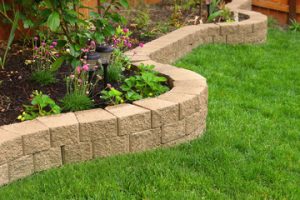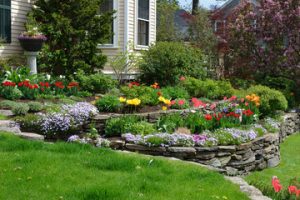A well-designed landscape can make your backyard more attractive, enjoyable and functional for entertaining or relaxing. Landscaping Cape Girardeau includes adding or removing plants, changing the terrain and building structures like walkways and fences.

Using scale and pacing can create balance in your landscaping, drawing attention to the most important elements in your design. Mixing in different textures adds interest and visual contrast.
Color is an important element to consider when designing a landscape. Whether it’s flowers, trees, or hardscape features, color can elevate the look of your garden and make it feel more connected and cohesive. A professional landscaper can help you find a color palette that speaks to you and complements the other elements of your garden.
You can also use color to create focal points and add depth to your landscape design. Warm colors like reds and yellows create a sense of excitement and closeness, while cool colors like blues and greens offer a more tranquil feeling. Using lines is another way to create focal points. Whether it’s a natural line between two plants, or a path or walkway that leads you to a specific feature, these lines create a pathway for your eyes to follow.
A strong brand identity can differentiate you from your competition and build trust with potential clients. A consistent logo, color scheme, and language creates a clear picture of your company’s personality and values. This makes it easier for clients to recognize your business and feel confident hiring you.
Keeping your landscaping color palette consistent throughout the year is another great way to grow your brand identity and keep customers coming back for more. Adding a few splashes of bright colors in spring and summer, and then switching it up with softer tones when fall rolls around will keep your garden looking fresh.
You can also incorporate your branding into marketing materials by using your logo on vehicle signage and using the same color palette on your website, social media, and advertising campaigns. This helps your potential customers recognize your company no matter what medium they are using to research you. It’s also a great way to increase customer referrals.
Form
Form refers to the overall shape and structure of plants and other landscape elements. It is a three-dimensional aspect of landscape design and contrasts with line by adding an extra dimension to the composition. Form can also help create a sense of order, directing movement or defining space within a landscape. It is also a great way to emphasize focal points in the landscape.
Nature provides a wide variety of forms for us to draw inspiration from when designing our own landscapes. From the round forms of shrubs like sheared boxwood or the round flower heads of alliums to the upright forms of trees such as Japanese Maples, we have a wealth of natural shapes from which to choose. Even the growth habit or how a plant is trimmed can contribute to the form of the landscape.
As with lines, form can have a significant impact on the overall aesthetic of the landscape and can either add or detract from its beauty. For example, a sheared hedge may add a sense of formality and order to a garden, whereas a loose Rhododendron can give the impression of a wilder, more unrestrained landscape.
Like all the other aspects of a landscape, form is best used in conjunction with color and texture to create balance and harmony. Using too much of one form can lead to monotony while a landscape filled with plants of the same shape can seem overbearing and stifling.
A well-designed and maintained landscape can enhance the visual appeal of your home and increase its value. It can also provide a number of benefits such as improving the quality of air and water, reducing soil erosion, and providing habitats for wildlife.
Landscaping is more than just planting trees and shrubs; it is a science that requires a thorough understanding of the elements of landscape architecture. When you work with a professional landscape company, you will have the peace of mind that comes from knowing your project is in the hands of a knowledgeable and experienced expert.
Texture
Color may be the most popular landscape element, but texture is equally important when creating a visually appealing outdoor space. Texture describes the size, shape, and roughness of a plant’s foliage, stems, or bark. When used effectively, texture creates contrast and visual excitement in your garden, transforming a flat, uninspired canvas into a vibrant living masterpiece.
A landscape’s texture can be created with a combination of different elements, including rocks, plants, mulch, and water features. The texture of these components can be soft, rough, or somewhere in between, depending on the desired effect. Using textures in your garden can create visual interest and help make it feel more natural and organic.
In landscape design, lines are an essential tool for directing the eye and providing focal points. They can be perceived as physical paths or walkways that lead the eye to a particular location, or they can refer to a line in a landscape, such as the border between two different surface materials, like grass and ivy; or the silhouette outline of any three-dimensional form like a rock, tree, or structure. Lines draw the eye into and around the scene, holding it within the landscape just as they do in a painting.
When combining different textures, it is important to think about the proportion of each. For example, a large mass of coarse texture can overwhelm the eye, while fine textures alone can be too delicate and may appear chaotic. The key to achieving balance is to incorporate medium-textured plants in between the coarse and fine, and to consider how your garden will look at different distances.
Another way to add a sense of texture is to use one of Bob Ross’s favorite techniques, dry brushing. By applying a very small amount of paint to a dry, clean brush, you can create the appearance of subtle, rough strokes. This technique can be applied to the foliage of plants as well, adding dimension and making them look more alive. The texture of the leaves and flowers of a hydrangea bush, for example, can be enhanced by a slight dry brushing with a textured paintbrush.
Space
Creating an organized and visually appealing landscape requires understanding the concepts of space and how to use them. The space around a house, garden, or other outdoor area is defined by the surrounding architecture, plants, and features, and it is important to consider all these factors when designing an effective landscaping plan. Landscaping can enhance the visual appeal of a home or business and increase its value, but it is also beneficial for environmental and health reasons. Plants can reduce air pollution by absorbing pollutants and releasing oxygen, and they can also provide shade and lower energy costs by reducing the need for air conditioning.
Landscaping is an ancient practice that dates back thousands of years, and it involves altering the natural environment by planting, trimming, and pruning trees, shrubs, flowers, and grass. It also includes the construction of structures like walls, patios, walkways, and water features. Some people landscape for aesthetic purposes, while others want practical improvements like erosion control, privacy, and drainage.
The different styles of landscaping reflect cultural preferences and climate conditions. For example, an English garden style creates serenity with floral displays and trimmed hedges, while the Japanese garden style encourages harmony with elements like rocks, koi ponds, and symbolic ornaments. Regardless of the style chosen, proper landscaping requires careful planning and regular maintenance to keep it looking its best.
Lines are an essential aspect of any landscape, and they can be used to create focal points and guide the eye throughout the garden. Straight lines have a formal character and are often associated with symmetrical balance, while curved lines tend to be more organic and natural. Lines are also important when designing the transitions between hardscapes and green spaces, like paths and walkways to gardens or edging for turf areas.
Sustainable landscaping practices are crucial for preserving natural resources and improving the quality of the soil. For example, drip irrigation and rainwater harvesting minimize water waste while promoting healthy plant growth. These practices help to reduce utility bills, promote biodiversity, and foster a more resilient ecosystem over time.
